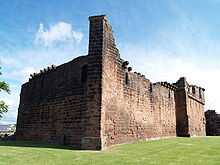Penrith Castle




Penrith Castle was built between 1399 and 1470 as a defense against Scottish raids. It is believed to have been first built by William Strickland who later become Bishop of Carlisle. The castle is situated within the town of Penrith, Cumbria, England opposite the railway station.
The Castle was later developed by the Neville family and passed into the hands of the Crown and is thought to have been the sometime residence of King Richard III when he was Duke of Gloucester and Lord Warden of the Marches Toward Scotland.
The castle and the town remained part of the Crown Estate until the reign of William III who gave it and most other Crown property in Cumberland to his friend Hans Willem Bentinck, 1st Earl of Portland. The castle eventually passed from the Earls and Dukes of Portland to the Dukes of Devonshire who sold it to the Lancaster & Carlisle Railway Company who built Penrith railway station. It later passed into the ownership of the Penrith Urban District Council, who in the 1920s converted the grounds into a public park and built housing nearby.
The castle is maintained now by English Heritage.
References
- ↑ Gilpin, William (1786), Observations relative chiefly to Picturesque Beauty, Made in the year 1772 ..... Cumberland & Westmoreland. Pub. R.Blamire, London. Facing P. 85
External links
| Wikimedia Commons has media related to Penrith Castle. |
- Visit Cumbria, Penrith Castle
- English Heritage, Penrith Castle
- The Cumbria Directory - Penrith Castle
- Lake District Walks - Penrith Castle
Coordinates: 54°39′44″N 2°45′26″W / 54.6621°N 2.7573°W
| ||||||||||||||